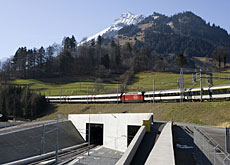Rail network enlarged for train-friendly Swiss

The Swiss Federal Railways is expanding its services in response to the rise in the number of passengers.
New lines and modifications to the network will help cut journey times across Switzerland and to neighbouring countries, it announced on Tuesday.
Since the introduction of the Rail 2000 project in December 2004, which was intended to attract new customers in Switzerland to public transport, the network has enjoyed a sizeable rise in passenger numbers.
In 2006 there were nearly 285 million rail passengers – a record year.
“Never have so many people travelled by train,” the head of the Swiss Federal Railways, Andreas Meyer, told journalists in Bern at a presentation of forthcoming timetable changes.
And during the first three months of 2007, the numbers of passengers again increased – by six per cent compared with the same period in 2006 – to 73 million. The Swiss remain the most train-friendly nation in Europe, taking an average of 42 rail trips a year.
According to the Swiss Public Transport Information Service, this enthusiasm for rail travel is down to good timetables as well as comfortable and modern trains and installations.
“We are now reaping the benefits of Rail 2000,” explained Meyer. “We are on the right track and demand for rail transport is likely to continue to rise.”
To meet this expected demand, further investment is needed to expand the Swiss network and infrastructure, he added.
High-speed links
Ahead of changes to the timetable in 2008 and 2009, the railways has been planning a series of major improvements to the network that will slash journey times.
The backbone is the new Lötschberg high-speed rail link, which will open on December 9. Trains will be able to travel at speeds of up to 200kmh, shaving travel time by a third between the capital and Brig in canton Valais and up to one hour to Italy.
The Basel to Milan journey will take four hours and, by taking the new high-speed TGV via eastern France, the Paris to Milan route should be reduced.
Also, from June 10 passengers will be able to board one of two new TGV trains travelling between Paris and Zurich and Basel, which will travel up to 320km/h between the French capital and Strasbourg, thus cutting journey times by 90 minutes.
And from December 2008 new services will be offered on the Gotthard line. High-speed trains will reduce journeys between Basel and Lucerne, and Arth-Goldau and Lugano.
Elsewhere, new tilting trains will reduce travel times on the Geneva-Milan and Zurich-Milan intercity routes.
“When looked at in terms of competition, the 2008 and 2009 timetables represent a major contribution towards improving rail efficiency,” said the director of passenger transport, Paul Blumenthal.
swissinfo with agencies
The state-owned Swiss Federal Railways net group profit of SFr259.4 million ($213 million) last year is the company’s second-highest profit since 2001.
Earnings before interest and tax jumped from a SFr79.2 million loss to a SFr343.8 million profit.
Profit from rail passenger traffic rose by 78.6% to SFr193.7 million.
Goods transport remained in the red, however, with losses reduced from SFr165.7 million to SFr37.3 million.
Problems also remain with the company pension scheme which is still in the red.
The group employed 27,933 staff in 2006.
The Swiss railway network spans more than 3,000 kilometres and has one of the highest densities in the world.
The system transported nearly 285 million passengers and more than 56 million tons of freight in 2006.
There are some 30 standard gauge railway companies, including Swiss Federal Railways, currently operating routes on Swiss territory.

In compliance with the JTI standards
More: SWI swissinfo.ch certified by the Journalism Trust Initiative











You can find an overview of ongoing debates with our journalists here . Please join us!
If you want to start a conversation about a topic raised in this article or want to report factual errors, email us at english@swissinfo.ch.